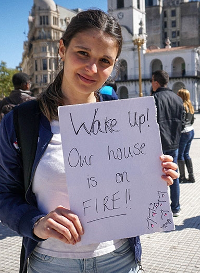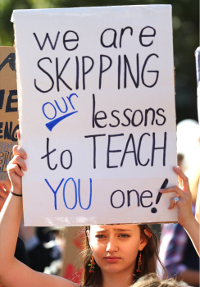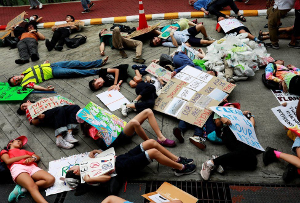|
4 Million Take Part in Climatestrikes Worldwide
September 21, 2019
In a larger version of events that have taken place with regularity during the last year, millions of people around the world took part in a ClimateStrike, a protest against inaction on climate change. As before, as the day dawned in the eastern Pacific, people gathered in cities far and wide (notably in nations like Kiribati and Vanuatu whose very existence is threatened by rising sea levels), marching and chanting and waving placards containing slogans like "There Is No Planet B." It wasn't just students, either. Many, many adults joined in the protests and rallies in more than 150 countries. Organizers estimated the worldwide turnout at 4 million. The gatherings have taken place largely on Fridays but have occurred on other days as well. The two largest took place in March and in May. The latest one took place on the Friday before the opening of a United Nations Climate Summit, which opens on Monday at U.N. headquarters in New York. In that city more than 250,000 people marched in support of action on climate change. The city's school district gave its students permission to leave school in order to join the protest. Some particulars:

One slogan chanted by many demonstrators in many countries was "Our house is on fire." That metaphor, which has become a rallying cry for the ClimateStrike movement, echoes a statement uttered by Greta Thunberg, the Swedish teen activist who has been a major inspiration in the movement. She said those words during a speech to the European Parliament in April 2019. Thunberg, who is now 16, soared to international recognition in 2018 by going not to school but to Parliament in Stockholm to protest. She had a wooden sign and some flyers, containing facts about carbon footprint and climate change. She spent what would have been her schoolday hours in front of Parliament, holding up the sign and handing out flyers. She went back the next day and found other people ready to stand with her. Every schoolday from then until Sept. 9–the day of her country's general elections–Thunberg spent outside Parliament, holding her own vigil; the crowds with her grew and grew. She wanted to call attention to the fact that her country's environmental policies were not necessarily in line with the 2015 Paris Agreement on actions needed to combat climate change. 
She is not attending school this year in order to focus fully on her campaign to raise awareness about climate change. She has led the charge for events around the world, including a series of Climatestrike days, in which students and adults in cities on most continents followed Thunberg's example and spent school hours protesting against the pace of climate change. Thunberg, who refuses to travel by plane because of the carbon emissions needed to make such a trip, spent about two weeks in minimal comfort aboard a solar-powered yacht. She made landfall and made her way to Washington, D.C., and to the White House, where she joined a group of students protesting inaction over climate change. She also attended the demonstration in New York City. She will attend the U.N. Climate Summit. |
Social Studies for Kids |
Social Studies for Kids
copyright 2002–2024
David White




 At the very moment that more than 500 protests across Germany took place (including one in Berlin that drew 100,000 participants), that country's government put out details of a very large plan to cut greenhouse gas emissions, thought to be one of the prime causes of
At the very moment that more than 500 protests across Germany took place (including one in Berlin that drew 100,000 participants), that country's government put out details of a very large plan to cut greenhouse gas emissions, thought to be one of the prime causes of 
